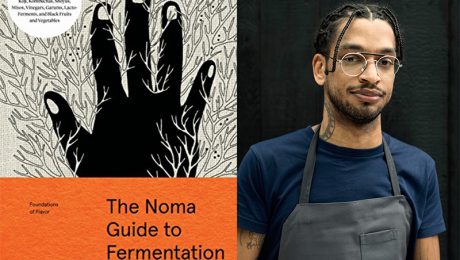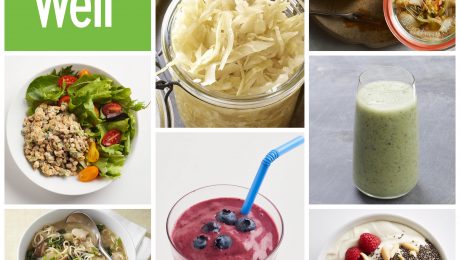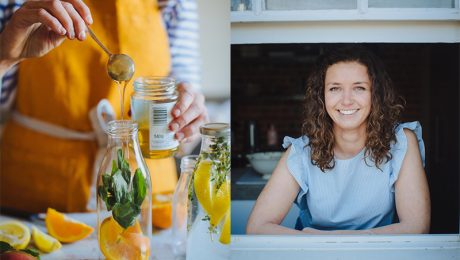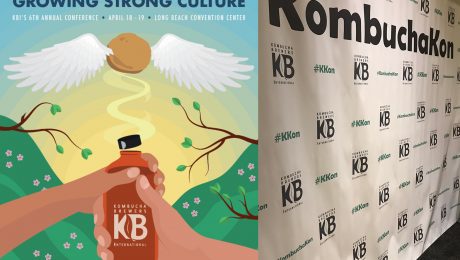“As the Fermenter, You’re Kind of the Bouncer Outside of the Nightclub,” David Zilber (Noma)
The creative genius behind Noma’s Fermentation Lab, David Zilber says one of the best parts of fermenting is “to get very nerdy and go really deep and taste the whole Patheon of flavors that the microbial world produces.”
Zilber, author of “The Noma Guide to Fermentation” with Noma founder René Redzepi, spoke to Science Friday about his extensive knowledge of the food science craft. When Zilber started at Noma in 2014, he had extensive experience working in high-end restaurants. He had made kimchi working in an Asian restaurant and cooked with amazing soy sauce imported from Japan, but he never gave a second thought as to where the ingredients came from. At Noma, Redzepi noticed Zilber “had a knack for science…I was usually the gut that had the far too detailed answer,” Zilber says laughing as he describes answering colleague’s food questions. Redzepi movied Zilber to the fermentation lab, a world-famous lab that has helped secure Noma’s Michelin ranking as the 2nd best restaurant in the world.
In the radio interview, Zilber details the fermenter’s roll as a scientist, gives advice on preventing mold and shares why he thinks everyone should have a koji started on their counter. Below are highlights from Zilber’s interview with Science Friday host, Ira Flatow.
What is fermentation?
Zilber: The most succinct way I can define fermentation, in Layman’s term, is it’s the transformation of one ingredient into another by way of a microbe. If you imagine you start out with cabbage, then you get lactic acid bacteria to grow in and alongside your cabbage, in two or three week’s time, you end up with sauerkraut. It’s not the same as it was going in. You’ve cultivated — cultured really — this microorganism in your container with your cabbage. And low and behold, this transformation has taken place.
The Noma book says there’s a fine line between rot and fermentation.
Zilber: The rest of the analogy is that, as a fermenter, there’s actually three people in play in the definition of fermentation: the ingredients, the vegetables or the food stuff, the microbes, but also the person whose acting on that situation and actually wiling the ferment into existence. As the fermenter, you’re kind of the bouncer outside of the nightclub. The guy with the velvet rope, the big muscly dude, and you’re deciding who gets into the club and makes a great evening where everyone is sipping champagne and beautiful people all around and all the drunkards and rowdy boys stay outside. So that velvet rope that you use as a fermenter, those are all sorts of control points. Whether that be salt or access to oxygen or temperature or PH and acidity levels, these are all things you have at your disposal as a fermenter to make sure you’re actually fermenting and not rotting. Rot’s a club where everyone gets in; fermentation is where the party is popping.
Take us through lactic acid bacteria and fermentation.
Zilber: Fermentation, it’s one of the simplest processes you could undertake. By adding a little bit of salt to let’s say were talking like sauerkraut. You have your cabbage, you shred it to rupture the cabbage cells, and it makes it easy for bacteria to get inside there. Now lactic bacteria are all around us. They live on your skin, they’re on the skins of fruits and vegetables, they’re basically ever present in our environment. And as you add salt to that shredded cabbage, you’re making sure that any malevolent microbes — things that might cause the mixture to rot — are kept at bay. Salt is a really great anti-microbial, but lactic acid bacteria have a little bit of resistant to it, they can tolerate salt up to a certain point. So, you kind of clear the playing field for lactic acid bacteria to do their thing. They start consuming the carbohydrates and sugar in that cabbage and in doing so they leave something else behind, and that something else is an exclusionary chemical. That’s lactic acid. It sours the mixture and then makes it even harder for different things to grow. And overtime, that fermentation process peters out, they consume as much sugar as they can, the PH drops because of all the lactic acid they’ve produced, you have sour cabbage literally translated from German sauerkraut.
What’s the difference between pickled and fermented?
Zilber: Anyway you break it down, a pickled product is fermented. Now there’s two routes to picking — you can either do a quick pickle, which is making vinegar and then boiling your vinegar with a bit of salt and sugar and spices and then pouring that over your vegetables, or you can sour your vegetables into a pickle. Now the difference is there’s two different acids at play in there. With a quick pickle, a vinegar pickle, you’re using acetic acid. But with a sour pickle, you’re using lactic acid. So, a vinegar pickle, you have to first make the vinegar, and that is the sugars of fruits first transformed into alcohol by yeast and then another fermentation process happens. You have acetic acid bacteria, another ever present bacteria that is floating on dust in the air that will settle on an open bottle of wine and eventually sour it into vinegar. That gets poured over your vegetables, whether that’s carrots or radishes or cucumbers, and the PH drops so much so that its effectively preserved.
Lactic acid fermentation, the sour pickle, that’s the process I just described with sauerkraut, you’re getting it all to happen at once, you’re getting that bacteria to grow in and around the vegetable you’re looking to ferment, and it sours the brine, it sours the plant matter itself, and in one shot you have a pickle you can keep in your fridge for months.
Does fermentation always produce alcohol as a byproduct?
Zilber: No, it does not. There are many different types of fermentation, and some types of fermentation have nothing to do with alcohol at all. Now a biochemist might say, technically, that’s wrong because the very strict, textbook definition of fermentation is the transformation of glucose into ethanol in an enzymatic pathway by yeast. But, in the real world, in the much broader sense, as I said there’s all sorts of different metabolites or byproducts that you end up with in fermentation. Sometimes its sugar or MSG, the actual flavor of umami. Sometimes its alcohol. Other times it’s acids. So there’s a whole plate of different end products in the world of fermentation. And the more you understand it, the more you can kind of paint with these flavors and really tweak the world of food to your will.
What are are your recommendations for someone getting into fermentation?
Zilber: For the novice, start with the things you like eating before you start making things you’ve never really had before, before you try and get into the first half into the process of making soy sauce, start with something you really like eating, if you love pickles on your hot dogs, make pickles for the first time. It’s really easy. It’s something you can do on your kitchen counter, you can watch it happen before your eyes. For a citizen scientist who wants to go a little deeper, I think it’s really fun to take like craft brewing and really try to understand the world of yeast, which there really are like tens of thousands of different varieties that all have these different flavor profiles.
And the coolest thing about fermenting at home, and really getting into it and getting really nerdy with it, is you almost get to taste places on earth in your own garage or in your own apartment. You can get yeasts from Belgium and taste a piece of history because these yeasts have been cultivated in the rafters of abbeys that Belgian monks are famed for making their beers in. So it is really cool to get very nerdy and go really deep and taste the whole Patheon of flavors that the microbial world produces. But that’s one of the funest parts about fermenting. Once you start making fermenter friends, people are just sharing culture and having a good time and you get to taste a little big or someplace else.
What are you excited about in fermentation?
There’s a lot of things that people in the world of fermentation know really well, that’s because all of these ferments that we consume on the regular — whether it’s chocolate or coffee or pickles or wine — these are all very traditional products that have been passed down through generations over hundreds of years, that’s why we still make them today. But in the same way that that makes fermentation amazing, I also think of the way pharmaceutical companies send out teams of scientists into the Amazon jungle to find a rare type of mushroom that might produce some type of miracle drug that will change the face of the pharmaceutical industry. I wish there was someone like that in the world of fermentation, looking for that rare microbe that would produce a flavor no one has ever tasted yet.
What exactly is kombucha?
Zilber: Kombucha is a sweet and sour microbial tonic, I guess you could call it. But folklore goes back to an ancient Korean physician that would travel around Asia, again I don’t even know when in history this would have taken place, but that this physician would brew this drink and kind of heal people with it. Kombucha is basically sweetened tea that is then fermented in a symbiotic way by yeast, which converts the sugar into alcohol, and then acetic acid bacteria that convert that alcohol immediately into acetic acid, the acid that you taste in vinegar, like white vinegar. Now if you drink kombucha and you buy it off the store shelf, sometimes it might taste really vinegary and that is probably because, in my opinion, it’s over fermented. The thing you have to understand about fermentation is fermentation is cooking, it’s just cooking that happens much more slowly. So just in the same way you can overcook a piece of chicken by roasting it in a pan for too long, you can also over ferment something like a kombucha and make it too sour by letting it ride out on your kitchen counter for three weeks instead of two. And sometimes if you taste a kombucha and you’re like “Oh, this it a little hard to get down,” try making it yourself with some of the guidelines in the book and you might find that’s its really, really pleasant to drink.
Are there live probiotics in kombucha?
Zilber: There can be. Kombucha can be pasteurized, just like you know milk can be pasteurized or canned goods can be pasteurized. You can heat it and kill everything in it and not really affect the taste that much. If they say that there are live cultures in it, it means that it was fermented and nothing was really done to it after it was put in a bottle. Now there’s a lot of conflicting information about kombucha out there. And I’ve read a lot of pretty hardcore studies that say, well, a lot of this is a bit bunk. But at the end of the day, I’d probably say that drinking kombucha is probably better for you than drinking a can of Coca-Cola.
How do you handle prevent mold in sauerkraut?
Zilber: That is something you are constantly trying to fight back, especially when you lacto-ferment in something like a crock. There are so many variables that go into making a successful ferment. How clean was your vessel before you put the food in there? How clean were your hands, your utensils? How much salt did you use? How old was the cabbage you were even trying to ferment in the first place? Every little detail is basically another variable in the equation that leads to a fermented product being amazing or terrible. It’s a little bit like chaos theory, it’s a little bit like a butterfly flapping its wings and Thailand and causing a tornado in Ohio. But with lots of practice, you’ll begin to understand that, if it was 30 degrees that day, maybe things were getting a little too active, maybe the fermentation was happening a little bit too quickly. Maybe I opened it a couple times more than I should of and it was open to the air instead of being covered. So there’s lots of variables. But I would say that, if you’re having a lot of trouble with mold, just up the salt percentage by a couple percent. It will make for a saltier sauerkraut, but it will actually help to keep those microbes at bay.
In the book, you say koji is indistinguishable from magic. What is koji?
Zilber: It’s the biggest microbe you’ve never heard of it. Koji is responsible for everything tasty that comes out of east Asia. From China to Korea to Vietnam to especially Japan, it is a mold, a helpful mold called aspergillus oryzae. It is responsible for turning the starches in rice and barley and all sorts of grains into sugar. And it’s turning the protein in those same grains into the flavor umami. It’s responsible for soy sauce, for sake, for rice wine vinegar, for miso and it can be used in all sorts of novel and inventive ways as well. But you never see it as a finished product because it usually is kind of the first step in that process. I liken it to the step of molting barley when you make beer or whiskey. That’s basically how ancient Asia’s civilization came about that process of turning grains into something sweet that you can then ferment with yeast. They found a mold instead of finding the process of molting, and it’s absolutely remarkable for the flavors it brings to the table themselves.
How do you get koji?
Zilber: There’s a line that I say when people ask “How do start growing koji.” All life comes from life, all life comes from cells. At the end of the day, everything living on earth today has been an unbroken chain of succession for three and a half billion years, and koji is no exception. If your kid wants a golden retriever puppy for Christmas, you have to find a golden retriever mom. And it’s the same for koji, you’re going to have find a koji breeder and actually get some spores from them. We buy ours from a laboratory in japan, and we have them shipped over to Copenhagen.
- Published in Science
Coca-Cola Invests $20 Million in Health-Ade Kombucha
Health-Ade Kombucha has secured a $20 million equity investment from The Coca-Cola Company. It’s a smart move for Coke — soda companies continue to loss more and more sales dollars as consumers are buying healthier, functional beverages. U.S. sales of kombucha were nearly $700 million in 2018. Health-Ade CEO Daina Trout said in a statement that Health-Ade needed an investor to help the brand grow, and Coca-Cola’s Venturing & Emerging Brands (VEB) has invested in Health-Ade since 2014.
Read more (BevNet)
- Published in Business
Eating Well Publishes 7 Must-Eat Fermented Foods for Healthy Gut
Dietician Lisa Valente writes in Eating Well the seven must-eat fermented foods for a healthy gut. Her list features: sauerkraut, kimchi, kefir, kombucha, miso, tempeh and yogurt. She writes: “Fermented foods are a hot health topic—and for good reasons. These good bacteria—particularly those in our gut—may improve digestion, boost immunity and help us maintain a healthy weight. Research is still emerging on just how important these mighty microbes might be for our health, but the early results are promising. Take care of your gut, and in turn, it will take help take care of you.”
Read more (Eating Well)
- Published in Health
Founder of Fermented By Lab Shares Food Diary Featuring Fermented Products
One question commonly posed by consumers starting to eat fermented products: How do I incorporate fermentation into my daily meals?
Alana Holloway, founder of Fermented By Lab, provides a great overview on how she uses fermented food and drinks. Hollaway’s food diary illustrates that it’s possible to include fermentation as a key element to every meal. Her simple meals are easy, delicious and highlight ways the average consumer can pair fermented food and drink with their regular food. Her dairy is also a great example of creative marketing fermented food brands can use to showcase ways to use their food.
Here’s Alana’s food diary, showcasing what she eats to keep her gut in good health.
Approach to food: I love to eat intuitively, according to the seasons… not only that, but according to the weather and how I’m feeling on any given day. After a lifelong battle with eczema, I have now found the key to managing it with the right foods for my body, and a complimentary lifestyle, too. I like to maintain a balanced, healthy gut and so eat/drink ferments every day… just as well I run a company that makes them!
Food Diary:
DAY 1 – FRIDAY
I tend to start day with about a pint of warm water. I really find it gives me immediate energy following sleep. I’m really not a lover of cold water, so will always drink it at room temperature or warm/hot.
I usually have breakfast about 10.30 as I struggle to eat too early in the morning. I like to allow my body time to build up a good hunger! Now that Spring is here, I’ve swapped my porridge for smoothies. This morning’s is organic cooked beetroot (I cook up a batch and then freeze it for smoothies), organic frozen strawberries from last Summer, a green banana, which is a great source of prebiotic fibre, coconut yoghurt, goats milk Kefir for the all-important probiotics, Plenish cashew milk (my favourite) and a little raw honey for a some more prebiotic love! I also take an omega 3 supplement; generally speaking, I’m not a massive supplement advocate and prefer to get what I need from my diet, but as I am prone to really dry skin, I find this one helps.
I grab a small handful of Brazil nuts as I head out the door.
At 1pm I have a chunk of goats Gouda and another pint on warm water whilst waiting for my lunch to cook. I can tell it’s going to be a hungry day for me today!
At 1.30, I have a lunch of sliced avocado roasted chickpeas with nigella seeds, soft boiled egg, roasted sweet potato, Fennel + Lemon Kraut from the Fermented by LAB Spring Collection, steamed broccoli & kale.
3.30 small glass of Kombucha as I need a bit of a kick!
At 7pm I have dinner – it’s lentil Dahl with Carrot + Coriander Kraut from last year’s Autumn Box (one of my favourite things about fermenting foods is getting to eat them months later!)
I drink a Golden Mylk before bed and soak some oats for tomorrow morning’s porridge… I mentioned Spring too early and hear it’s due to snow tomorrow!
DAY 2 – SATURDAY
10am – I start the day with two huge mugs of warm/hot water again and follow it with the porridge I soaked last night. I always soak my grains/pulses/legumes to make them easier on my digestive system. My porridge toppings are roasted rhubarb, coconut yoghurt, a little raw honey and some chopped Brazil’s.
3pm – Lunch is a chunk of goat’s milk Gouda (I can’t get enough of it!) and roasted broccoli, carrot, fennel, sweet potato and nigella seeds with a soft-boiled egg (again!) Despite it being the weekend, I’m working and need something easy to cook which doesn’t require too much thought!
5pm – I have a bottle of Red Grapefruit + Rosemary Kefir from the Spring Box. I’m lucky enough to be able to delve into a good selection of seasonal ferments… it means I don’t get bored with eating the same Kraut all the time!
7pm – I try to stop eating by 8pm so that I can give my digestive system a break overnight. As I had a late lunch, I’m not overly hungry so make a beetroot, carrot (both cooked and frozen), blackcurrant, green banana and goats kefir smoothie and have a mug of chicken bone broth.
I drink a small Golden Milk just before bed. They really relax me and as I have a history of eczema, find they really help keep my inflammation at bay.
Best piece of advice about health + wellbeing?
Don’t search for all the answers in one place. Every day, I try to remind myself that it’s not just about a healthy diet, a good exercise regimen, good quality sleep or daily meditation practice, for example, it’s a combination of all of them that allows you to live your healthiest and happiest life.
- Published in Food & Flavor, Health
New York Times Publishes How-To on Home Brewing
Further sign that kombucha has hit the mainstream: The New York Times publishes a how-to on home brewing kombucha, “How to Make Kombucha, or How I Met Your Mother.” Their photo of a scoby hotel — or “scotel” as the article calls it — is stunning.
Read more (New York Times)
- Published in Food & Flavor
Future of Kombucha will be Local Brands, Educating Retailers & Adapting to Change
Kombucha brands biggest competition are not other kombucha brands – it’s soda and functional beverages. Sales continue to hemorrhage in the soda category as consumers shun sugar-filled drinks. And kombucha companies have a great opportunity now to grab that market share.
A panel of leaders in the kombucha and beverage industry shared their insights on the future of kombucha at KombuchaKon, Kombucha Brewers International’s 6th annual conference. They agreed the fermented tea is not a fad, but brands “have to be nimble and creative” to thrive in an increasingly crowded market.
“The future is really, really bright,” said John Peirano, the vice president of marketing at Humm Kombucha. “It’s super exciting – and we’re just getting started.”
Local Brands Will Reign
As more and more kombucha brands enter the industry, the brand’s biggest strengths will be selling to their regional market.
“There are all these local brands retailers are going to want because they care about what’s happening locally,” Peirano said. “Local brands are going to be really, really important.”
John Craven, editor of beverage industry news site BevNET, has covered the beverage world for nearly two decades. He said marketing brands locally works in the kombucha category, but not in any other beverage space.
“Prior to (kombucha), if you said ‘I want to build a regional brand,’ I would have said ‘That’s not a thing,’” Craven said.
Educating Retailer & Consumer
Retailers want to give \consumer’s a variety of product choices, Craven added. They’re more likely to commit to selling kombucha if there are multiple brands and SKUs on their store shelf.
“With (kombucha), it’s OK to like a bunch of different brands,” Craven said. It’s normal for a kombucha consumer to switch between different brands and flavors. “That is one thing this category has going for it that’s really unique. … It definitely has defied traditional beverage logic in that regard.”
Litigation against kombucha brands continues to top headlines, as lawsuits claim alcohol content is misrepresented or sugar levels are understated in different brands. In the next few months, KBI will be releasing their own standards defining kombucha.
Truth in labeling will drive trust with the consumer and the retailer, Peirano said. “It’s important that what’s inside the bottle is on the label,” he added.
“As category leaders, we also have to be category captains. We have to go to the retailers with really strong selling stories. And those selling stories aren’t just about Humm. Those selling stories are about the category and what will drive the most profitability for that retailer category and that shelf set, so they can be successful.”
Refrigerated kombucha and the fermented beverage category has grown 31.4 percent year-over-year, according to data from SPINS market research. And household awareness continues to climb – it increased 20 percent in 2018.
Kombucha is sold in the refrigerated section, some of the most expensive space on a grocery shelf.
“I think it’s all our responsibilities, if we want to continue to grow this category, we’ve got to go out and education and tell people about the magical, beautiful benefits of what kombucha brings to the table from a functional health standpoint,” Peirano said.
Brands Need to Remain Fresh
The kombucha industry is already dominated by a handful of national brands – GT Kombucha, Kevita, Health Ade, Humm Kombucha and Brew Dr. control the majority of market share. The panel agreed smaller brands can still successfully enter the category, but the top sellers are locked.
“There’s not room for a dozen million dollar-plus brands,” Craven said. “But the reality…is that some of these (smaller) brands will be acquired and will probably be absorbed and evolved, ruined, whatever, which makes an opportunity for the next brand to come along.”
“There are a lot of functional products out there…the beverage history lesson is consumers are really fickle,” Craven added. He pointed to Vitamin Water as an example, a brand that rapidly grew popular in the beverage industry but then lost sales. “The consumer keeps moving on to the flavor or the function of the month, so to speak.”
Craven does not think kombucha will be a victim like Vitamin Water because kombucha includes value-added health benefits. The kombucha brands that survive the next decade, though, must be adept to change. They must evolve with new flavors and brewing styles, while maintaining affordability, consistency and health benefits.
Growing Kombucha Enhancement: CBD
One of those kombucha styles keeping the industry fresh: CBD. Conrad Ferrel, founder and CEO of True Büch, said combining the benefits of the cannabis plant with the functional compounds in kombucha makes sense.
“The evolution of cannabis used with kombucha, it’s a natural marriage,” Ferrel said. “If you want to have kombucha for sleep, there will be a specific kombucha for that. If you want it for pain management, it will be there. It will be functional and specific to the certain (medical aid) people want.”
There are 140 compounds in the cannabis plant, but so far only two – THC and CP – have been studied, added Ferrel. CP is a value-added compound, known to aid in improving medical ailments. But science is lagging.
“As the world gets used to the science … the struggle is to sell people something that for years was considered a drug, now we’re trying to sell people on the fact that it’s good for you,” Ferrel added.
Hard Kombucha Gaining Traction
Hard kombucha is another brewing style keeping the kombucha category competitive. It’s evidence of how many beverage categories kombucha bleeds into – like alcohol, tea, juice, flavored water and functional beverages.
Kyle Oliver, quality assurance scientist at Boochcraft, said regular kombucha has an ABV of .5 percent to 2 percent. Hard or high alcohol kombucha goes above that level. Boochcraft has 7 percent ABV. The ABV is higher because hard kombucha goes through a secondary fermentation process, where more yeast and sugar are added.
“Our organisms we want in our kombucha are spoilage organisms in other industries (like wine and beer),” Oliver said. “The higher ABV doesn’t kill probiotics, they’re able to still grow in that environment.”
- Published in Business
Fermentation Reigns: Sour Taking Over Our Tastebuds
Sour is taking over our taste buds. A New York Times Style Magazine article explores how sour flavor is “dominating our dining discourse.” The article lists fermenting, kombucha, sourdough, kimchi, drinking vinegar, cocktail shrubs and sour beer as evidence of sour’s ascent in American’s palates. Samin Nosrat, author of the book of cohost of the Netflix series both titled “Salt, Fat, Acid, Heat,” says acid is one of the building blocks of flavor and makes our mouth water. “...your body gets confused — maybe I want more?”
Read more (New York Times Style Magazine)
- Published in Food & Flavor
GT Dave Endorses KBI’s New Standards Defining Kombucha
On the cusp of an announcement from KBI on standards defining kombucha, GT Dave — founder of GT’s Kombucha — gave KBI a $1 million endowment to protect authentic kombucha. Speaking to attendees at the annual KombuchaKon, GT said: “Kombucha is now being mass produced by some newer brands that have entered the market and they are positioning them for a mainstream palate. These barely fermented products are missing the heart and soul of what the industry of kombucha should be, and it’s looking more like a new age soft drink.” GT believes kombucha brands need to be upfront about what techniques they’re using to make their kombucha, like pasteurization, hyper-filtration, artificial carbonation, concentrate use and/or spinning cone technology.
Read more (Food Navigator)
- Published in Business
Kombucha is Growing, But Retailers Are Ready to Axe Brands
The kombucha industry is exploding – sales were up 21 percent to $728.8 million last year. Kombucha and non-alcoholic fermented beverages are now the third largest beverage category, representing 10 percent of total refreshment beverage sales.
Distribution is high at conventional, natural and convenience stores. But velocities (sales) are declining.
“A word of caution – there’s going to be a reckoning,” said Bobbi Leahy, director of sales at SPINS, a natural products market research group. “All these retailers are taking all these lovely kombuchas … they will be evaluating you, probably far soon than you think is warranted. There will be some slashing going on.”
Leahy spoke at KombuchaKon, the Kombucha Brewers International (KBI) annual trade conference in Long Beach. The year’s KombuchaKon was the industry’s largest since the first conference six years ago, with 424 attendees from 17 countries.
“I applaud you all on the growth. I think that’s wonderful,” Leahy said. But “I would be ready with some materials to go in and defend your spaces.”
In her presentation on the kombucha market analysis and future trends, Leahy emphasized that refrigerated beverage shelves are expensive retail space. She shared advice with kombucha brands on how to survive the current high distribution wave. The SPINS analysis is based off 52 weeks of sales ending in February 2019. Her tips:
- Prepare with Sales Materials. If kombucha sales can’t keep up with distribution, retailers will have to answer to their higher-ups. Why is there so much kombucha on the shelf that isn’t selling? Leahy warned brands to be the ones educating retailers, advising brands to share data points and score cards. She added: “I encourage you to go and get ahead of that, be the one talking that message. You tell them what the right set is, you tell them what they should do, you know this industry. If they’re overstocked on something, then let them know. They’re looking to you to be the experts.”
- Conventional supermarkets reign. The bulk of kombucha and fermented beverage sales are coming from conventional supermarkets. “If you succeed in the conventional channel, you’ll have success overall because they represent 70 percent of sales,” Leahy said.
- Don’t ignore convenience stores. Convenience store (like 7-11 and gas stations) sales of kombucha and fermented beverage sales are growing 55 percent. “You have to make it a task to go after convenience,” Leahy noted. “You probably wouldn’t have said ‘That’s my low-hanging fruit, I’m going to go in there.’ But they’re certainly getting the message now … It’s certainly worth having a plan to go after convenience.”
- Craft different sales messages for each channel. Don’t go in to retailers with the same message. Between conventional, convenience, natural and specialty stores, each channel will care about different things.
- Know region’s sales trends. The west coast – especially California – has high kombucha sales. The south central, mid-south and Great Lakes regions are under-indexing in kombucha sales. Leahy pointed out that the west is a ready audience and a great spot to experiment with new flavors. The south and Great Lakes regions, though, need an education focus. Demos are a great idea in the area.
- Highlight brand’s best attributes. Boast about characteristics beyond the label. Features like: clean label, sustainability, brand mission, wellness goals, social impact and great ingredient sources.
- Top selling flavors are solid. Ginger and berry are the two top flavors across all channels. The “fruit – other” is also a top selling flavor and growing (135 percent), which is defined as unique fruit flavors like watermelon, guava and melon. The past year, there has been the strongest growth in flavors: apple (172 percent), grapefruit (155 percent), pomegranate (104 percent) and orange (98 percent).
- Tread lightly with unique flavors. Leahy pointed out, if a unique flavor only appeals to a small audience, a conventional retailer will notice only a small number of customers are buying it. “That small and that low is going to be kind of a perfect storm,” she said. “You really want to be careful.”
- Smaller size bottles sell best. The 14- to 17-ounce size kombucha make up the majority of sales.
- Start sales promotions. Coupons, mailers and sales are great options to get products off shelves.
- Use your social network. Let people know which stores you’re at.
- Maintain a good store locator. Brand’s websites should feature a good store locator detailing which stores carry which flavors of kombucha.
- Top kombucha brands dominate the market. GT Kombucha, Kevita, Health Ade, Humm Kombucha and Brew Dr. account for 88 percent of kombucha sales at conventional retailers and 89 percent of kombucha sales at convenience stores. GT Kombucha, Kevita, Health Ade and Brew Dr. account for 77 percent of kombucha sales at natural stores and 82 percent of kombucha sales at specialty gourmet stores. Those same top brands likely will not change, Leahy noted.
- Know beverage trends. “The trends you are seeing in kombucha are special and unique,” Leahy said. “…as you’re sitting across a buyer or a category manager or retailer, you want to be well-versed in what other beverages are on the shelf and which ones they’re probably going to protect.”
- Natural beverages are contributing more to the growth of the refreshment beverage category than non-natural. The conventional, shelf-stable beverages (like Coke and Pepsi products) account for 63 percent of the refreshment beverage industry, but only 53 percent of growth. Diet soda is especially losing favor among consumers. Specialty and wellness beverages (like energy drinks and Gatorade) make up 29 percent of sales and 35 percent of growth, especially driven by energy drinks. Natural drinks (like kombucha and La Croix) make up 8 percent of sales, but natural is driving 13 percent of growth.
- Of the natural beverage subcategories, shelf-stable performance beverages (like Body Armor) are experiencing the biggest growth at 87 percent. Declining categories include shelf-stable coconut water (-12 percent) and juices (-3 percent).
- Emphasize growth of natural products industry. Natural products are no longer a niche market. The natural products industry is estimated to reach $140 billion in sales in 2019. In 2003, natural products were a $52 billion industry.
When SPINS began tracking kombucha sales years ago, Leahy noted kombucha was “barely a blip on the map.” Current Kombucha sales numbers are also likely higher than noted – major retailers Costco and Whole Foods do not share sales data with SPINS.
“In a way, it’s a good problem to have – you can’t sell if you’re not on the shelf,” Leahy said. “ou’re on the shelf – now it’s time to sell.”
- Published in Business
KombuchaKon 2019 Kicks Off Largest Conference in History
KombuchaKon 2019 starts today in Long Beach! The 6th annual conference by Kombucha Brewers International is the association’s largest-ever conference. Kombucha is a rapidly growing beverage category, projected to grow at a CAGR of 13% to $3.5 billion in sales by 2025. For more information, check out KBI.
- Published in Business










